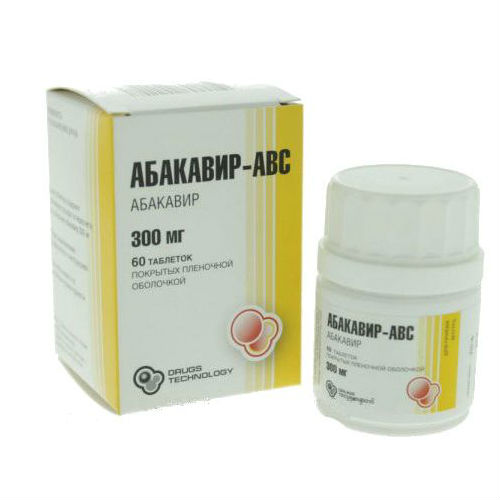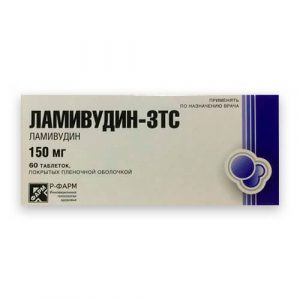Description
Pharmacological action
Antiviral agent, a synthetic carbocyclic analogue of nucleosides. Inside the cell, abacavir is converted, with the participation of cellular enzymes, into the active metabolite carbovir triphosphate. Carbovir triphosphate is an analogue of deoxyguanosine 5′-triphosphate (dGTP). Carbovir triphosphate inhibits the activity of HIV-1 reverse transcriptase, which is due to competition with the natural substrate of dGTP and the violation of its incorporation into viral DNA. The loss of the 3′-OH group in the integrated nucleoside analog prevents the formation of 5′- and 3′-phosphate ester bonds necessary for the elongation of the DNA chain. As a result, viral DNA growth stops.
Indications
Treatment of HIV infection in adults and children over 12 years of age and weighing more than 30 kg (as part of combination antiretroviral therapy).
Contraindications
– Hypersensitivity to abacavir or any other component of
– children under 12 years of age and weighing less than 30 kg
– moderate to severe hepatic insufficiency (Child and Pugh classes B and C), due to the lack of clinical data and the recommended dosing regimen
– mild liver failure (class A on the Child-Pugh scale), due to the inability to provide a dosing regimen.
Caution:
Patients with a possible risk of coronary heart disease combined use of abacavir and ribavirin.
Composition
1 tab. contains: Active substances: abacavir sulfate 351.38 mg, which corresponds to the content of abacavir 300 mg.
Excipients: microcrystalline cellulose – 380.12 mg, sodium carboxymethyl starch – 24 mg, colloidal silicon dioxide (anhydrous) – 4.5 mg, magnesium stearate – 20 mg.
Film composition: opadry yellow (13K52177) – 20 mg: hypromellose – 11.8 mg, titanium dioxide – 5.2 mg, triacetin – 1.6 mg, iron dye yellow oxide – 1.2 mg, polysorbate – 0.2 mg.
Dosage and Administration
Abacavir-ABC is taken orally, regardless of food intake. The drug should be prescribed by a doctor who has experience in treating HIV infection.
Adults, adolescents and children over 12 years old and weighing more than 30 kg
The recommended dose of the drug Abacavir-ABC is 600 mg once a day (2 tablets of 300 mg) or 300 mg 2 times a day (1 tablet of 300 mg).
Special patient groups
Patients with impaired renal function
In patients with impaired renal function, dose adjustment of Abacavir-ABC is not required.
Patients with impaired liver function
The use of abacavir is contraindicated (for this dosage form, due to the lack of clinical data and the recommended dosage regimen).
Side effects
The nature of the adverse reactions, other than the hypersensitivity reaction, but observed in patients taking abacavir, is not completely clear. Whether these adverse reactions are the result of using abacavir or a wide range of other drugs that are simultaneously prescribed for the treatment of HIV infection, or whether they are caused by the disease itself, has not yet been established. Many of the following adverse reactions associated with taking abacavir (nausea, vomiting, diarrhea, fever, fatigue, rash) are usually observed with the development of a hypersensitivity reaction to abacavir. Therefore, when any of these symptoms appears, a thorough examination of the patient is indicated to confirm the development of a hypersensitivity reaction.
If abacavir was canceled due to the appearance of the above symptoms and a decision was made to resume abacavir therapy, then this can only be done under direct medical supervision.
Very rare cases of polymorphic exudative erythema, Stevens-Johnson syndrome or toxic epidermal necrolysis in which a hypersensitivity reaction to abacavir could not be excluded have been reported. In such cases, you must permanently stop taking medications containing abacavir.
Most of the adverse reactions listed below are not limiting. The frequency of occurrence is determined as follows: very often ( 1/10), often ( 1/100 and <1/10), infrequently ( 1/1000 and <1/100), rarely ( 1/10 000 and < 1/1000), very rarely (<1/10 000). Clinical trial data Metabolism and nutritional disorders: often – loss of appetite. Disorders of the nervous system: often – headache. Disorders of the gastrointestinal tract: often – nausea, vomiting, diarrhea. General disorders: often – fever, drowsiness, fatigue. In controlled clinical trials, it was shown that changes in laboratory parameters during treatment with abacavir are observed infrequently, as in the control group of patients not receiving the drug. Post-registration observation data Metabolic and nutritional disorders: often – hyperlactatemia rarely – lactic acidosis, accumulation and / or redistribution of adipose tissue. The frequency of this adverse reaction depends on many factors, including the antiretroviral drugs used in combination with abacavir. Gastrointestinal disorders: rarely, pancreatitis (a causal relationship with abacavir has not been established). Disorders of the skin and subcutaneous tissue: often – a rash (in the absence of systemic manifestations) is very rare – polymorphic exudative erythema, Stevens-Johnson syndrome and toxic epidermal necrolysis. Cases of lactic acidosis have been reported, sometimes fatal, usually associated with severe hepatomegaly and fatty liver, using nucleoside analogues. The use of combination antiretroviral therapy has been associated with redistribution of adipose tissue (lipodystrophy) in HIV patients, including a decrease in the subcutaneous fat layer on the face and limbs, an increase in intra-abdominal and visceral fat, an increase in mammary glands, and dorsocervical fat deposition (buffalo hump). The use of combination antiretroviral therapy has been associated with metabolic disorders, such as hypertriglyceridemia, hypercholesterolemia, insulin resistance, hyperglycemia and hyperlactatemia. In HIV-infected patients with severe immunodeficiency, inflammatory reactions to asymptomatic or residual opportunistic infections may occur during initiation of combination antiretroviral therapy. Cases of autoimmune diseases (for example, Graves disease) that occur under conditions of immune reactivation have also been reported, but the timing of the manifestation of the disease is more variable, and these phenomena can develop many months after the start of therapy. Cases of osteonecrosis have been reported, especially in patients with well-known risk factors, advanced HIV infection, or long-term use of combination antiretroviral therapy. The frequency of this phenomenon is unknown. Description of selected adverse reactions Hypersensitivity The hypersensitivity reaction to abacavir has been defined as the general adverse reaction in the treatment of drugs containing abacavir. Signs and symptoms of a hypersensitivity reaction are given below. These signs and symptoms were identified during clinical trials or during post-registration observation. Symptoms and signs that occur in at least 10% of patients with hypersensitivity reactions are shown in bold. Almost all patients with a hypersensitivity reaction develop a fever and / or rash (usually maculopapular or urticaria) as part of the syndrome, but such reactions can occur without a rash or fever. Other major reactions include gastrointestinal symptoms, respiratory system or constitutional symptoms, such as drowsiness or malaise. Disorders of the skin and subcutaneous tissue: rash (usually maculopapular or urticaria). Disorders of the gastrointestinal tract: nausea, vomiting, diarrhea, abdominal pain, ulceration of the oral mucosa. Disorders of the respiratory system, chest and mediastinal organs: shortness of breath, cough, sore throat, adult respiratory distress syndrome, respiratory failure. Disorders of the nervous system: headache, paresthesia. Disorders of the blood and lymphatic system: lymphopenia. Disorders from the liver and biliary tract: increased biochemical parameters of liver function, hepatitis, liver failure. Disorders from the musculoskeletal and connective tissue: myalgia, myolysis, arthralgia, increased activity of creatine phosphokinase. Disorders from the kidneys and urinary tract: increased serum creatinine concentration, renal failure. General disorders: fever, fatigue, malaise, swelling, lymphadenopathy, arterial hypotension, conjunctivitis, anaphylactic reactions. The resumption of taking Abacavir-ABC after a hypersensitivity reaction to abacavir leads to a quick return of symptoms within a few hours. A repeated hypersensitivity reaction is usually more severe than the first, and may include life-threatening arterial hypotension and death. In rare cases, reactions also occur when resuming therapy with Abacavir-ABC after its withdrawal, caused by the appearance of only one of the main symptoms of the hypersensitivity reaction (see above), and in very rare cases, this reaction occurs when you resume taking the drug Abacavir-ABC in patients who had no symptoms of the hypersensitivity reaction before discontinuing the drug (i.e., in patients previously considered abacavir-tolerant). Drug Interactions In vitro studies and data on the main metabolic pathways of abacavir indicate a low likelihood of drug interactions involving abacavir. Abacavir does not inhibit metabolic processes involving the CYP3A4 isoenzyme of the cytochrome P450 system. In vitro studies have found that abacavir does not interact with drugs that are metabolized by the isoenzymes CYP3A4, CYP2C9, or CYP2D6. During clinical trials, no increase in hepatic metabolism was detected under the influence of the drug. Therefore, the interaction of abacavir with HIV protease inhibitors and other drugs metabolized with the participation of enzymes of the cytochrome P450 system is unlikely. Clinical studies have not identified clinically significant interactions between abacavir, zidovudine, and lamivudine. The use of abacavir concurrently with rifampicin, phenobarbital and fetonoin (inducers of uridine-5-diphosphate-glucuronyl transferase) can lead to a slight decrease in the concentration of abacavir in plasma. ethanol. Ethanol slows the metabolism of abacavir a. resulting in AUC of abacavir increasing by approximately 41%. Given the safety profile of abacavir, these changes can be considered clinically insignificant. Abacavir does not affect the metabolism of ethanol. methadone. In a pharmacokinetic study, co-administration of abacavir at a dose of 600 mg 2 times / day and methadone led to a decrease in Cmax of abacavir by 35% and an increase in the time of its achievement by 1 hour. Moreover, under the curve, the concentration in the plasma – time did not change. These data are believed to have no clinical significance. In this study, abacavir increased the average systemic clearance of methadone by 22%. For most patients, these changes are not clinically significant, but sometimes a further increase in the dose of methadone may be required. Retinoids. Retinoids (e.g., isotretinoin) are inactivated by exposure to alcohol dehydrogenase. Interaction with abacavir is possible, however, no special studies have been conducted. Ribavirin. Particular care must be taken while prescribing abacavir and ribavirin, since a decrease in the concentration of phosphorylated metabolites of ribavirin is possible, which in turn can lead to a decrease in the effectiveness of treatment in patients simultaneously infected with HIV and hepatitis C. virus receiving pegylated interferon and ribavirin therapy. Active substance Abacavir Terms of delivery from pharmacies Prescription dosage form tablets



